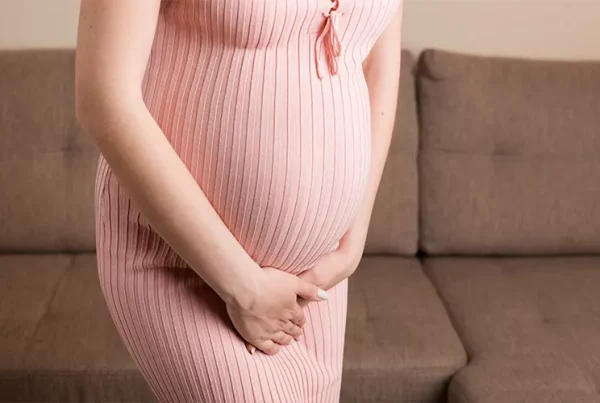During the pregnancy journey, your body undergoes many changes as it accommodates your growing baby, and this may lead to some pains and discomforts which are natural. However, it could sometimes be a sign of a serious underlying problem when the pain is severe or persistent. Urgent hospital referral is often required, unless a harmless cause can be confirmed with certainty in the absence of maternal or foetal distress.
So when are abdominal pains normal and when should you think of seeking medical help? First, let’s start with understanding what causes abdominal pains in pregnancy.
What causes abdominal pains in pregnancy?
Often, it is due to muscle strain from a growing uterus, constipation or gas. The biggest fear expecting mothers have is that of premature labour or something else going wrong with the pregnancy. However, there are other non-pregnancy related causes of abdominal pains that can occur during pregnancy that may or may not require urgent intervention. In early pregnancy, an ectopic pregnancy must be excluded before diagnosing any other cause of abdominal pain.
The Obstetrics-related causes of abdominal pains can range from premature labour, to complicated issues related to placental tissue infection/tearing, uterine tearing or liver-related complications. These conditions are not common and thankfully most pregnancies remain healthy and uneventful.
Finding out the non-Obstetrics-related cause of abdominal pain is more complex in pregnant women. This is because the large uterus and the changing position of abdominal organs, as a result, may hide the usual classic signs. Acute appendicitis is the most common general surgical problem encountered during pregnancy. The most common symptom of appendicitis, i.e., right lower quadrant pain, occurs close to McBurney’s point in the majority of pregnant women, regardless of the stage of pregnancy; however, the location of the appendix migrates a few centimetres upwards with the enlarging uterus, so in the third trimester after 24 weeks, pain may localise to the mid or even the upper right side of the abdomen.
The other possible causes can be a constipation colic or a simple urinary tract infection. However, it could also be due to more serious issues like symphysis pubis dehiscence (a terribly painful complication where walking down stairs is impossible without pain/tenderness right in the middle of the central pubic bone). Serious surgical causes that may need an immediate operation include conditions such as appendicitis, gallbladder inflammation or ovarian accidents (where an ovarian cyst ruptures, bleeds or twists and loses its blood supply). They may be associated with a fever and changes noted on blood tests.
In emergency cases of unknown causes of abdominal pains in pregnant patients, they may need joint assessment both by a gynaecological and obstetrics team, as well as a surgical team. Where the diagnosis remains unclear, the risks of surgery must be balanced against the risks of delayed diagnosis which could lead to pregnancy complications.
When should you seek help?
Pregnant women should call their obstetricians if the abdominal pain doesn’t go away after several minutes of rest, or if they have any of the following signs or symptoms concurrently:
● Vaginal bleeding
● Vaginal discharge with an unusual colour, consistency or smell
● Fever, chills or rigours
● Nausea/Vomiting
● Feeling giddiness, lightheaded or fainting
● Burning sensation when passing urine
● Hardening of the uterus/contractions
● Decreased foetal movement
It is also important to consider the trimester during which the abdominal pains occur.
During the first trimester, most discomfort can be due to harmless ligamentous pain, gas, constipation, easily treatable urinary tract infection or presence of a large corpus luteum cyst (which usually disappears by 12 weeks of pregnancy).
In the later stages (after 24 weeks), patients will have general aches due to uterine enlargement and mild-severe pelvic girdle pains. Some may require a referral to a good physiotherapist or a chiropractor to alleviate the discomfort. The biggest concern is that of preterm labour. This presents with regular painful uterine hardening (of the whole area of the uterus), which may be accompanied via vaginal clear copious discharge or bleeding.
Patients may start to feel a painless tightening sensation in their uterus from time to time. They are known as Braxton Hicks contractions. Before 37 weeks, these Braxton Hicks contractions should be infrequent, irregular, and essentially painless. These are very worrying to a first-time mother-to-be but are harmless. It is your uterus “practising” for the big day! As long as the patient has no pain and no associated vaginal bleeding or discharge and the baby is moving well, she can be reassured.
How does your Obstetrician investigate?
As mentioned before, the location of the pain varies in pregnancy due to movements of the organs as the uterus enlarges.
A quick examination of mother and baby allows doctors to assess if either one is in any imminent danger. If the baby’s heart rate is good, water level normal and growth fine with no evidence of contractions, you can be reassured that there is no preterm labour. A vaginal examination may be done to ensure no cervical dilation.
A “Surgical Abdomen” is one where it hurts when the doctor presses onto the area and the pain worsens when they remove their hand. This is known as “rebound tenderness”. Another sign is “guarding” where the tummy hardens to touch due to irritation from within the tummy cavity, either from inflammation or infection. These are the serious signs to look out for.
Your doctor will then likely order a series of blood tests and decide on scanning for the cause if necessary and if the patient is still stable. If the patient’s vitals are unstable, doctors may go ahead and resuscitate her and decide on an exploratory surgery to save her.
An MRI is the safest scan of choice to assess these conditions as an ultrasound may not be able to scan past the enlarged uterus and CT scans contain radiation. They help doctors look into the abdomen clearly and assess the site of the inflammation or infection needing treatment. If a surgery is necessitated, having it done after 12 weeks’ gestation is safe and many pregnancies continue successfully to term after the mother recovers from her surgical emergency.
What You Need To Know:
- It is always better to play safe during pregnancy. If you are unsure, please check yourself to the nearest maternity hospital and your obstetrician will be able to assess the cause of the pains.
- If an abdominal pain (no matter how mild) is constant and lasts for more than 10-15 minutes despite resting, consult your doctor.
- If the abdominal pain is getting stronger in intensity, waking you up from sleep, or associated with fever, vaginal bleed/discharge, fainting, uterine hardening or decreased fetal movement, seek the nearest maternity hospital.
- Most abdominal pains in pregnancy have a benign harmless or easily manageable cause behind it.
- Even in the most serious of non-obstetrics-related surgical emergencies, many patients have undergone surgeries and their pregnancies are known to continue successfully to term. The mother’s health is of utmost importance and must be taken care of.
- The safest scan to assess for non-obstetrics related abdominal pains in pregnant women will be the MRI scan, which is only done in the most serious of cases which may require surgery during pregnancy.
Sources:
http://www.webmd.com/baby/your-guide-prenatal-testing
https://www.smgwomenshealth.sg/pregnancy/services/
https://healthengine.com.au/info/pregnancy-ultrasound-obstetric-ultrasound
https://www.healthline.com/health/pregnancy/prenatal-testing
https://americanpregnancy.org/pregnancy-complications/sharp-pain-pregnancy/



